These notes are intended to provide a casual sky watcher or someone already into amateur astronomy living in Eastern Australia with a summary of what is happening in the night sky in March 2013. The finder charts have been produced for an observer based in Brisbane (Queensland, Australia) but will be useful for observers elsewhere in Eastern Australia.
Instructions on how to obtain customised satellite viewing information for your location can be found here. If you find this page of interest, you may wish to follow this website automatically using Twitter and the sites RSS Feed.
Planets for March 2013
All times AEST
Jupiter is easy to locate as soon as evening twilight ends. Just look above the North West horizon for the brightest star you can see. On 1 March, Saturn rises around 9.20 pm and rises around 7.20 pm at the end of March. Saturn appears as a pale yellow moderately bright star to the unaided eye above the Eastern horizon after the times given previously. It’s rings are visible in even a small telescope. Neptune and Mercury rise shortly before the Sun at the start of March and gain altitude as the month progresses. Venus is effectively lost in the glare of the Sun until April when it reappears in the evening sky. Uranus and Mars are also lost in the glare of the Sun.
Individual sky events (March 2013)
All times AEST
1 March 2013: Gibbous Moon and Spica (brightest star in ancient Greek constellation Virgo The Virgin) close. Late evening sky. Look above the Eastern horizon.
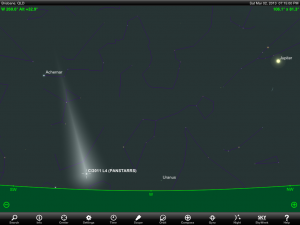
2 March 2013: Look for Comet 2011 L4 Panstars low above the Western horizon as evening twilight ends (binoculars recommended). Note that you should only use the finder chart an an indication of where the comet will be located – not what it will look like.
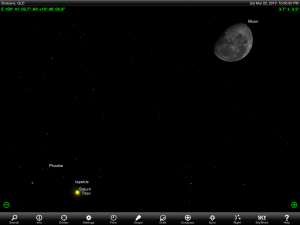
2 March 2013: Gibbous Moon and Saturn close. Late evening sky. Look above the Eastern horizon.
4 March 2013: 11 pm Mercury in inferior conjunction
5 March 2013: 7.53 am Last Quarter Moon
6 March 2013: 9 am Moon at perigee (369,957 km from Earth in it’s orbit)
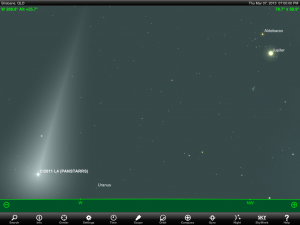
7 March 2013: Look low above the Western horizon for Comet 2011 L4 PANSTARRS as evening twilight ends. Binoculars are required for the best view.
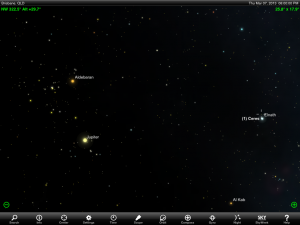
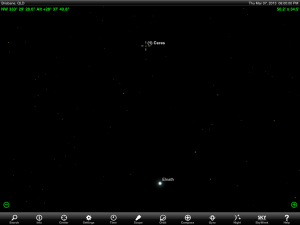
7 March 2013: Asteroid/Minor planet Ceres 0.4 degrees South of Elnath (Beta Tauri). Early evening sky. Ceres will be at magnitude +8.4. This means that it should be visible to an observer equipped with a pair of binoculars 10 x 50 binoculars under dark sky conditions. Note that Ceres will only appear like a star – even in a telescope. The best way to confirm you are looking at the correct ‘star’ is to observe it over the following few nights. Ceres will move. A star won’t.
12 March 2013: 5.51 am New Moon
15 March 2013: Venus at greatest latitude South
17 March 2013: 7 am Mercury stationary
18 March 2013: Neptune 0.05 degrees North West of asteroid/minor planet 44 Nysa
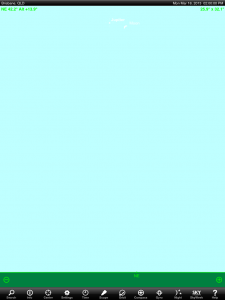
18 March 2013: 2 pm Try looking for Jupiter during the day with a pair of binoculars. Look above the North East horizon for the crescent Moon. Look to the left and slightly above the Moon (as per the finder chart). Given clear sky conditions, you will be able to see Jupiter. Standing in the shadow of a building or tree usually helps.
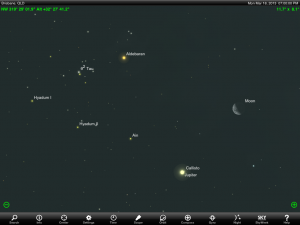
18 March 2013: Jupiter, crescent Moon and Aldebaran (brightest star in ancient Greek constellation Taurus The Bull) make a temporary triangle low above the North Western horizon at the end of evening twilight
19 March 2013: 1 pm Moon at apogee (404,261 km from Earth in it’s orbit)
20 March 2013: 3.27 pm First Quarter Moon
20 March 2013: 9 pm Autumn Equinox
22 March 2013: Mercury at descending node
22 March 2013: Midnight Asteroid/Minor planet 14 Irene 0.05 degrees West of M100 in Coma Berenices
27 March 2013: 7.27 pm Full Moon
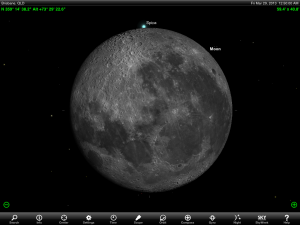
29 March 2013: Spica occulted by Moon for most of Queensland and the Northern part of the Northern Territory. More information: http://asa.usno.navy.mil/cgi-bin/occnwdo.cgi?dir=2013/occns&file=occn.2013Mar28.Spica&body=Spica From Brisbane, Spica is occulted by the Moon at 12:52 am and reappears at 1.22 am. At least a pair of binoculars is recommended to observe this occultation due to the brightness of the Moon
29 March 2013: 3 am Venus in superior conjunction
29 March 2013: 11 am Uranus in conjunction with Sun
29 March 2013: 6.43 am Watch the launch of the next crew to the International Space Station live on NASA TV via the Internet (http://www.nasa.gov/multimedia/nasatv/index.html).
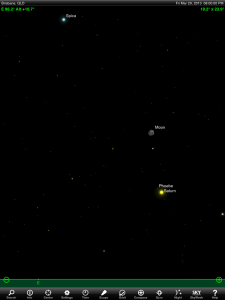
29 March 2013: Waning gibbous Moon located above Saturn. Early evening sky. Look above Eastern horizon.
31 March 2013: 2 pm Moon at perigee (367, 504 km from Earth in it’s orbit)
For Further Information
Customised Astronomy & Satellite Viewing information
Information on how to obtain customised astronomy & satellite viewing information for your location can be found here on this website.
References
The information in this post has been prepared using the following references.
Astronomy 2013, Quasar Publishing http://www.quasarastronomy.
Sky Safari Pro Ipad app, http://www.southernstars.com/
6 thoughts on “March 2013 Sky & Space Events”